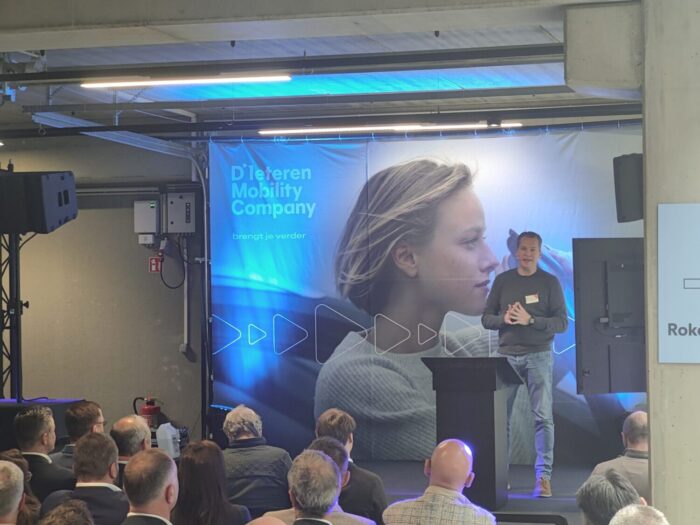On April 18th, D’Ieteren Mobility Company opened its latest flagship store and Let’s Talk FLEET used the occasion to host a session about Artificial Intelligence in the Automotive Industry. Headlight was present to talk about how we use A.I. in fleet management.

Huge potential for A.I. in fleet management
LLMs, or Large Language Models, leverage foundation models for generative capabilities like reasoning, problem-solving and creative expression at a human level. They are capable of understanding language and performing complex tasks through natural conversation.
The democratization of LLMs by industry leaders such as Anthropic (Claude 3), Meta (Llama 3), and OpenAI (ChatGPT) has ushered in a new era of accessibility and innovation. By democratising access to LLM technology, these industry players are empowering businesses, researchers, and developers to create more intelligent, efficient, and personalised solutions across diverse domains, including fleet management.
Indeed, there is a huge potential for automation of human interpretation/classification tasks in fleet management. Think about driver questions, checks on quotes, incident reports, invoices,.. A.I.-powered solutions could help fleet managers in reducing their operational workload. Today, up to 75% of time is spent on manual coordination and communication effort, despite the repetitive nature of the tasks.

LLMs, powering A.I. in fleet management (Source: AWS)
Examples of how Headlights applies A.I. in fleet management
In different parts of the Headlight application, A.I. is used to enhance the fleet management experience, both from the employee and the fleet management perspective. In what follows, we’ll focus on two examples, one for the driver, and one for the fleet manager, on how we leverage A.I. in fleet management.
1.Use Case 1: Driver Q&A
Based on our interviews, fleet managers spend up to 30% of their time on (recurring) driver questions. As we envision a seamless organisation of corporate mobility, recurring driver questions should be eliminated, so that the fleet manager can focus on the questions where human input is required.
Our digital assistant, Lucy, can help you fleet managers by generating responses to (recurring) policy or process questions.
Getting started is very simple:
- First, build the Company Knowledge Base
- Insert your Car Policy text clauses
- Add FAQs
- Headlight adds the driver context (employee details, vehicle details) for each employee
- Next, when a driver asks a questions to the fleet manager, or to Lucy, Headlight performs a semantic search to generate a response
- Headlight can thus provide a response to the driver message via:
- our Digital Assistant (Lucy)
- the Fleet manager account, with optional approval/edit step.
As 80% of driver questions are related to the policy, this support reduces the amount of e-mails drastically. Compared to a traditional call center, availability is 24/7, with all information directly available, and responses always consistent.
What’s better: Headlight already shows the policy clauses or FAQs that most likely contain the answer to the driver, BEFORE they hit enter. A.I. in fleet management therefore also prevents the questions being asked, and thus the operational workload.
2.Use Case 2: Headlight Evaluate
Quite a number of tasks in fleet management require human interpretation from the fleet manager.
For example, is a pdf with a dealer quote in line with the car policy? Does it have the required options? Are all discounts applied? Is the chosen colour a business colour? As another example, an email from the dealer about a delivery date change might require some (fixed) follow-up steps: extending the current contract, or order a short-term rental to bridge a potential delay.
In Headlight, you can use the workflow steps to “pre-evaluate” documents and text and heavily reduce the operational work.
For instance, your A.I. in fleet management, via our digital assistant Lucy, can:
- alert you whether a quote seems to be in line with the policy, for example by flagging that a quote seems to contain a non-EV vehicle, and providing adequate reasoning.
- start the right process if it detects in a message that certain follow-up actions are required
The interpretation and reasoning at human-level can help the fleet manager in far quicker processing of workload
Conclusion
These are just two of the many use case in which we at Headlight apply A.I. in fleet management. Modern corporate fleet management does not longer require a set-up with a team of support people and administrative roles – most recent technology, notably A.I. in fleet management, can be leveraged for a vast majority of support and even interpretation and processing of follow-up administration.
Of course, a Human-In-The-Loop (HITL) remains crucial, but the role of the fleet manager will shift to a more strategic role, and value-added tasks such as improving the policy and operational setting, while leaving the rest up to the software.
For more information about Headlight and how our platform can benefit your business, please visit our website at www.headlight.tech.
Press coverage
FLEET.BE: https://www.fleet.be/lets-talk-fleet-ai-wordt-eerder-copiloot-dan-automatische-piloot/
